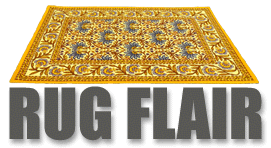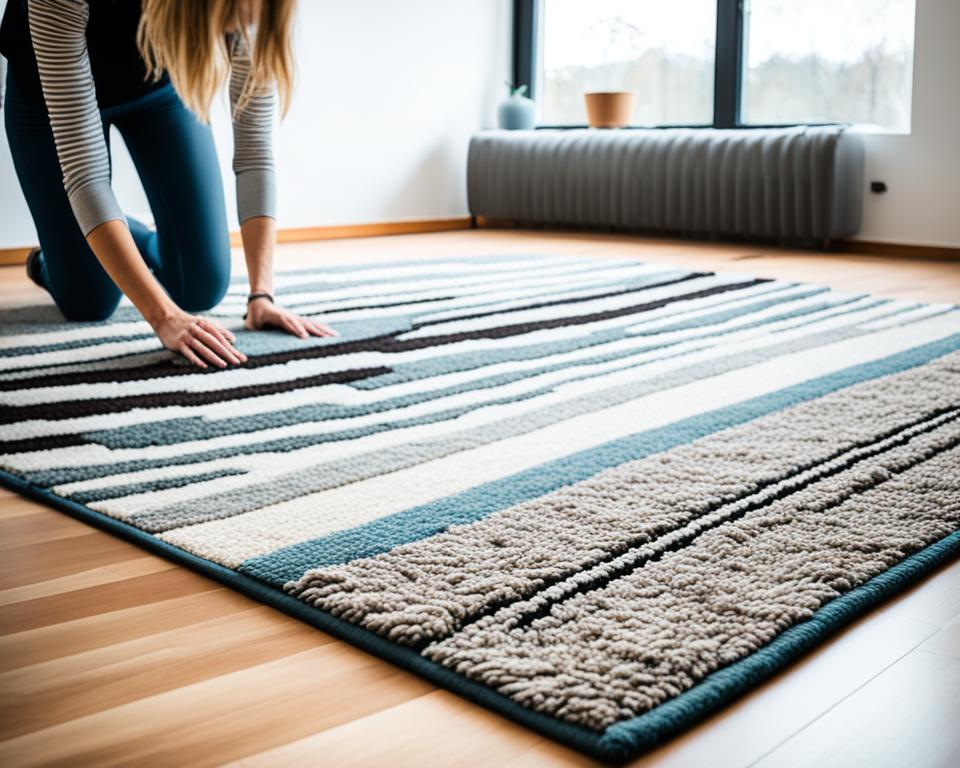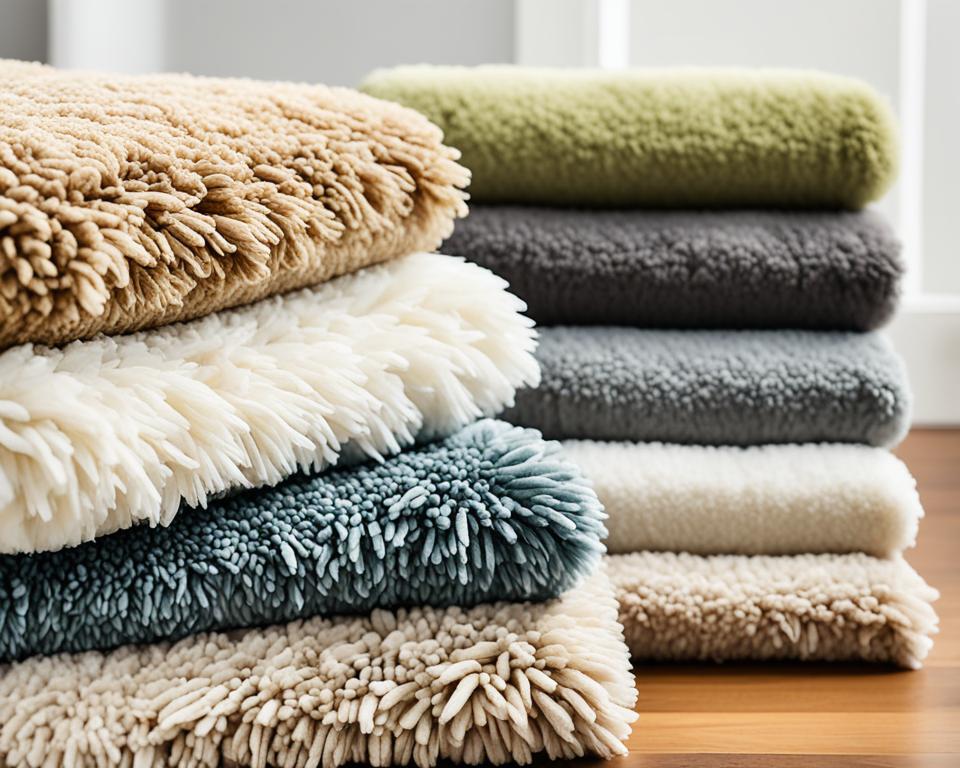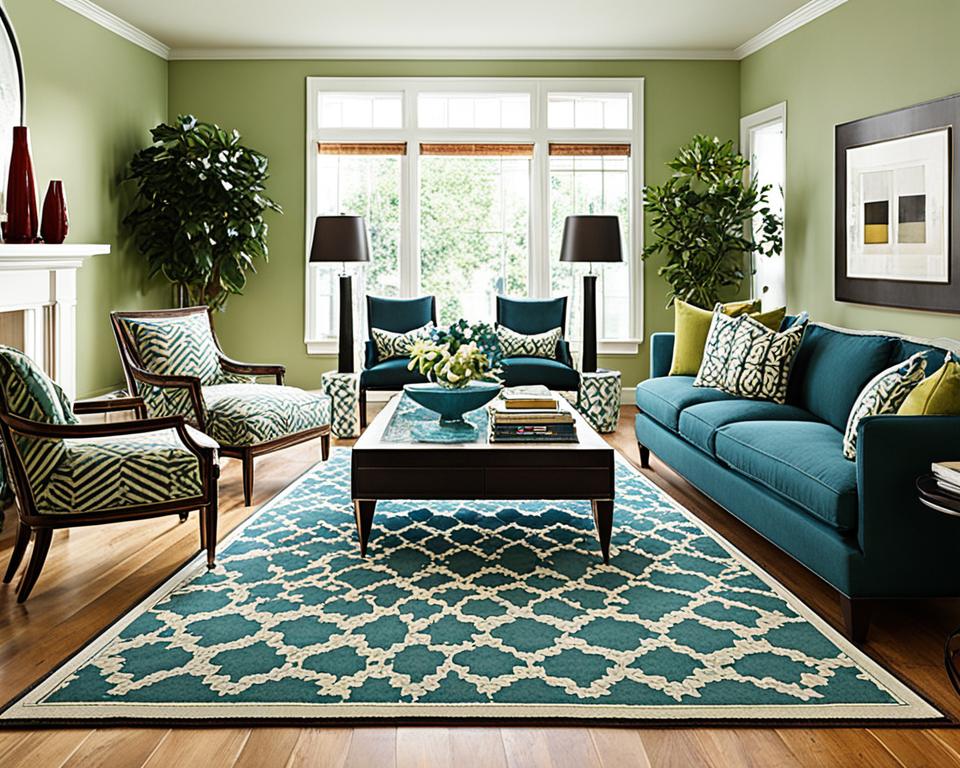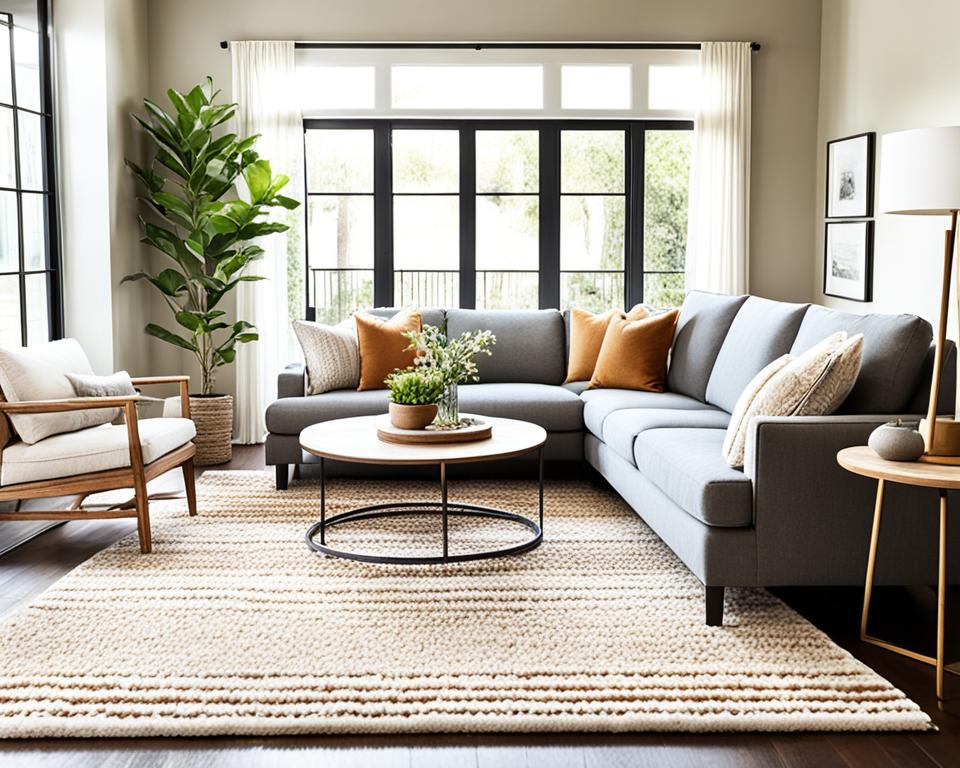When it comes to furnishing your home with cozy and stylish decor, selecting the perfect area rug is often at the top of the list. However, if you’re one of the many individuals asking, “are rugs bad for allergies?”, you might want to consider more than just the color and pattern of your next rug purchase. Allergies from rugs can arise due to unwelcome guests like dust mites, pet dander, and mold thriving in fibers under your feet.
Thankfully, hypoallergenic rugs exist as savvy solutions to keep your sniffles at bay. As you search for the best rugs for allergies, it’s important to note that allergy-safe rug options are specifically designed to improve your home environment. Whether you’re looking for stylish hypoallergenic rugs or just want to ensure your existing decor is not exacerbating allergy symptoms, awareness and wise choices can make an immense difference. Let’s uncover the truth about rugs and allergies and explore options that support a happy, healthy home.
Key Takeaways
- Understanding if rugs contribute to allergies is key for a health-conscious home.
- Hypoallergenic rugs are designed to minimize allergens and maximize comfort.
- Materials matter: Select rugs that prevent the growth of dust mites and mold.
- Routine cleaning is essential to keep allergies from rugs under control.
- With a range of allergy-safe rug options available, you can choose decor that aligns with both style and well-being.
Understanding the Relationship Between Rugs and Indoor Allergies
If you’ve ever wondered why allergies seem to flare up more often inside homes with rugs, you’re not alone. Various culprits such as dust mites, pet dander, and mold find a comfortable habitat in the fibers of your area rugs, potentially leading to those unpleasant allergic reactions. By delving into the relationship between rugs and allergens, you gain valuable insights that could help in reducing allergens in rugs and maintaining a healthier home environment.
How Rugs Can Trap Allergens and Pollutants
Rugs are notorious for their ability to capture and retain a variety of allergens and pollutants that affect indoor air quality. Materials like wool or synthetic fibers in rugs can house dust mites, while pet dander finds refuge in the cozier spots of your shag carpets. When thinking about rug materials for allergies, it’s important to look for those that resist the absorption and buildup of these allergy triggers.
The Impact of Carpet Age and Type on Allergen Accumulation
The type and age of your rugs play a significant role in allergen accumulation. While newer, tightly woven rugs may initially ward off dust and allergens, over time, they can become as laden with irritants as their older, looser counterparts. Transitioning to allergy-friendly rugs made from materials less hospitable to allergens could be beneficial for reducing your home’s allergen levels.
Comparing the Allergen Levels in Homes with Rugs Versus Smooth Floors
Studies have found that homes with smooth flooring tend to have lower levels of allergens compared to those with carpeted surfaces. Accumulation of allergens like dust mites is particularly less in homes with hardwood, tile, or laminate flooring. Nevertheless, not everyone prefers a home without the warmth and style of rugs. If you’re partial to rugs, selecting one designed for reducing allergens could help bridge the gap between aesthetics and health.
| Rug Type | Ease of Cleaning | Allergen Resistance | Recommended for Allergies |
|---|---|---|---|
| High-Pile Rugs | Difficult | Low | No |
| Low-Pile Rugs | Easier | Medium | Yes, with regular cleaning |
| Smooth Floors | Easiest | High | Yes |
Remember, whether it’s the plush carpet in your living room or the elegant area rug in your dining area, being mindful of the material and upkeep can result in better air quality for you and your loved ones. Stay tuned as we continue to explore how you can keep your home chic, comfortable, and allergy-friendly.
Discovering the Effects of Rug Materials on Allergies
As you contemplate the cozy addition of a new rug to your home, the material you choose could have a significant impact on allergy sufferers. Rugs can act as a haven for allergens, but selecting the right type can mitigate allergic reactions to rugs and contribute positively to your indoor living space.
Natural Fibers Versus Synthetic: Which Is Better for Allergy Sufferers?
When weighing the choice between natural and synthetic fibers, consider that natural fibers, such as wool, cotton, and jute, have inherent properties that resist allergens. These materials inherently provide a less hospitable environment for dust mites and other common allergens. Synthetic rugs, while sometimes more affordable and available in a variety of designs, may harbor chemicals from their manufacturing process, making them less ideal for those prone to allergies.
The Role of Wool Rugs in Allergy Prevention
Wool rugs stand out in the realm of natural fibers with their unique hypoallergenic properties. The natural oils found in wool not only repel dust mites but also inhibit the growth of mold and mildew, two common triggers for allergic reactions. A well-chosen wool rug can be a reliable ally in the fight against indoor allergens, positioned as an ideal choice for both comfort and health.
Identifying Hypoallergenic Rug Options for Your Home
In your hunt for hypoallergenic rugs, it’s crucial to consider not just the materials but also the construction and treatment of the rug. Low-pile structures prevent the trapping of allergens and ease the cleaning process. Be on the lookout for rugs labeled as hypoallergenic, as these have been designed with your health in mind.
Whether you’re drawn to the charm of natural fibers or the versatility of synthetic rugs, make an informed decision that accounts for not only aesthetics but also the allergy-friendliness of the rug. Your choices can significantly influence the wellbeing of everyone in your home.
Evaluating the Allergic Reactions to Rugs in Sensitive Individuals
Have you ever walked into a room, only to be greeted by a sneezing fit or itchy eyes? It’s possible that the culprit could be right under your feet. For those who are sensitive, the rugs you have chosen for their beauty and comfort could be harboring allergens that trigger uncomfortable reactions. Identifying the signs and understanding what studies have found may help you select the best rugs for allergies, creating a healthier environment in your home.
Signs That Your Rug May Be Causing an Allergic Reaction
If you find yourself frequently battling symptoms like sneezing, itchy skin, or even asthma attacks without a clear cause, it might be time to look down. Allergic reactions to rugs are not uncommon, and the signs can be quite telling. A stuffy nose after lounging on the floor or persistent coughing can be indicators that your rug materials are not as allergy-friendly as you need them to be.
Are Rugs Bad for Allergies: Analyzing Scientific Studies
Studies suggest a link between certain types of carpeting and indoor air quality issues. For example, high pile rugs and old carpets tend to trap more allergens, which can exacerbate allergy symptoms. Research has identified sick building syndrome—a condition where occupants experience health issues potentially linked to time spent inside a building—as being associated with certain types of carpeting. To guard against these risks, it’s vital to choose rug materials for allergies that are known for being more hypoallergenic.
As per the scientific communities’ findings, high pile carpets and old rugs often accumulate not just dust and dirt, but also allergens and volatile organic compounds (VOCs) that can lead to sick building syndrome. The studies underscore the importance of opting for low-pile or woven rugs made from materials such as wool, which not only resist the retention of allergens but also minimize the presence of VOCs.
Ultimately, if you or your loved ones are sensitive to indoor allergens, taking an informed approach to your rug choices can make a world of difference. Consider adopting rugs made from natural fibers, which have been shown to act as natural deterrents to dust mites and mold growth, to ensure a safe and comfortable home for everyone.
Exploring Allergy-Friendly Rugs and Their Benefits
Creating an allergen-free environment in your home involves careful consideration of every decor element, particularly when it comes to floor coverings. Allergy-friendly rugs, strategically designed to address this precise concern, are the ultimate solution for anyone prioritizing health alongside aesthetics in their living spaces.
Understanding the distinct advantages of hypoallergenic rugs can not only enhance the quality of life for those with sensitivities but also contribute to overall indoor air health. These rugs, often crafted from natural fibers such as wool, cotton, jute, and sisal, offer twin benefits: they’re tough on allergens and kind to your health.
So, what makes these materials ideal for combatting allergens? The answer lies in their ability to inherently resist bacteria and mites, thanks to their natural properties which make them uninviting homes for unwanted microscopic guests. Moreover, these rugs are remarkably easy to maintain, ensuring that cleanliness complements their innate hypoallergenic nature.
When you consider the best rugs for allergies, it is essential to examine how they align with your household needs. For instance, if easy-clean, durability, and anti-bacterial characteristics rank high on your list, a tightly woven wool rug might be your best choice. Wool’s natural ability to repel dust mites and its moisture-regulating properties ensure a fresher, cleaner floor surface.
For those desiring the perfect marriage of functionality and design, here’s a comparative look at few options:
| Allergy-Friendly Rug Material | Benefits | Maintenance Level |
|---|---|---|
| Wool | Natural oils repel dust mites; Regulates humidity; Durable | Regular vacuuming; Professional cleaning recommended annually |
| Cotton | Soft to touch; Hypoallergenic; Biodegradable | Machine washable or easy spot cleaning |
| Jute | Low pile; Anti-static; Sustainable material | Vacuuming and spot cleaning; Avoid moisture |
| Sisal | Sturdy natural fiber; Anti-microbial; Resistant to dust accumulation | Regular vacuuming; Dry cleaning methods preferable |
As you personalize your living space, selecting a suitable rug is more than an aesthetic choice—it is a health-conscious decision. Reflect on the specific needs of your home environment and remember that the right rug can elevate both your style and your wellness. Choose wisely, and enjoy the tranquility of an allergen-reduced living area.
The Scientific Perspective on How Rugs Influence Sick Building Syndrome
When considering the impact of indoor decorations on your health, the role that rugs play in sick building syndrome is a pressing concern for many. With a recent surge in indoor environmental awareness, understanding the scientific connections can provide you with actionable knowledge to improve your living or working spaces.
Investigating the Link Between Rugs and Volatile Organic Compounds (VOCs)
One element that often goes under the radar but has a significant impact on indoor air quality is the presence of volatile organic compounds, or VOCs. These are chemicals that can off-gas from varied sources, including rugs, especially new ones. Indoor environments, where such emissions occur, can contribute to a collection of ailments—often lumped together under the term sick building syndrome. Symptoms such as headaches, dizziness, nausea, and eye irritation might be linked to VOC exposure from your seemingly harmless floor coverings.
Indoor Air Quality Concerns Associated with Rugs in Buildings
While we routinely seek to make our rooms aesthetically pleasing with the addition of plush, colorful rugs, it’s crucial to assess their impact on indoor air quality. Older carpets or those with high pile often trap more allergens and pollutants, adversely affecting the air you breathe inside. This is particularly problematic in buildings with limited ventilation, where such pollutants can accumulate, exacerbating the effects of sick building syndrome. It’s essential to weigh these factors when selecting floor furnishings to ensure a healthy indoor atmosphere.
Through scientific lenses, it becomes evident that the relationship between rugs and indoor air quality is complex and necessitates a thorough consideration of material choices, ventilation, and maintenance to mitigate potential health risks. Keeping abreast of these insights can enable you to create an indoor environment that is both comfortable and conducive to well-being.
Actionable Tips for Reducing Allergens in Rugs
Living with allergies can be a struggle, especially when your home’s decor contributes to the problem. Rugs, while adding warmth and style, can also harbor allergens. But don’t fret! With the right know-how, you can maintain an allergy-safe home by reducing allergens in rugs through simple yet effective methods.
Before jumping into solutions, it’s important to recognize the role that rugs play in indoor allergy flare-ups. Whether it’s the luxurious high-pile carpets or the rugged charm of a jute mat, each type possesses the potential to trap allergens. However, adopting proper cleaning techniques and embracing hypoallergenic rugs can significantly diminish your discomfort.
Proper Vacuuming Techniques to Minimize Allergens
Not all vacuuming is created equal when it comes to extracting allergens from your rugs. The use of a vacuum with a High-Efficiency Particulate Air (HEPA) filter is vital in trapping fine particles that other vacuums might re-emit into the air. Ensure you’re vacuuming at least once a week and, ideally, with a vacuum cleaner certified to be allergy-friendly.
Proper technique is also key. Slow, deliberate passes increase the vacuum’s effectiveness, allowing it to capture more allergens. Occasional deep vacuuming sessions—and remember to wear a dust mask—can also help keep allergens in check. Investing in HEPA filters is an actionable step toward a healthier home.
Natural Methods to Eliminate Dust Mites and Allergens from Rugs
For those inclined towards natural cleaning methods, there are a host of options to help reduce the presence of dust mites and other allergens in your home. A simple yet effective approach is to sprinkle baking soda on your rugs. Allowing it to sit before vacuuming can greatly assist in neutralizing odors and absorbing allergens.
Regulating the humidity in your home can also deter the proliferation of dust mites, as they thrive in moist conditions. Using dehumidifiers and maintaining a humidity level of around 50% will make your home less hospitable to these tiny pests. Additionally, using natural sunlight can eradicate dust mites—occasionally air out small rugs and mats in direct sunlight for a few hours.
Wool rugs can be a worthy investment too, as they are naturally hypoallergenic. Still, they need care. Regular maintenance is paramount to making the best of these allergy-safe rug options. Now, let’s explore a comprehensive table listing some cleaning agents and their effectiveness in allergen control:
| Cleaning Agent | Use-Case | Effectiveness |
|---|---|---|
| HEPA-filter Vacuum | Weekly rug cleaning | High |
| Baking Soda | Allergen neutralization | Moderate |
| Dehumidifier | Regulate home humidity | Effective in high-humidity regions |
| Sunlight | Airing out rugs | Moderate to High (Weather Dependent) |
Implementing these techniques can be a game-changer for allergy sufferers. When coupled with choosing hypoallergenic rugs from the start, your home can become a sanctuary from sneezes and wheezes. And if you’re on the lookout for new rugs, don’t miss the upcoming section where we’ll navigate the world of hypoallergenic rug options.
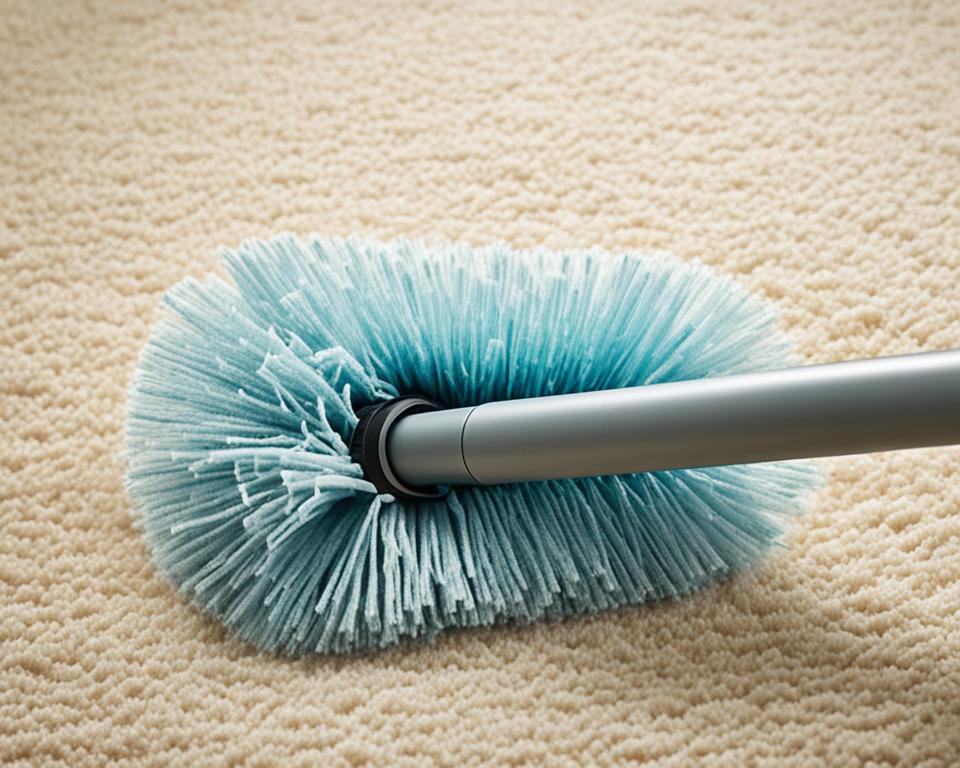
Breathing Easy: The Best Rugs for Allergy Sufferers
For those looking to create a comfortable home without compromising on health, considering the best rugs for allergies is essential. Hypoallergenic rugs are not just a trend—they’re a breath of fresh air for allergy sufferers, designed to offer a reprieve from sneezes and itchy eyes. Allergy-friendly rugs made from materials like wool, jute, and sisal stand out for their natural ability to deter common household allergens, ensuring a cleaner, healthier indoor environment.
Discovering a rug that supports your health doesn’t mean sacrificing style or comfort. Wool rugs, for instance, are renowned not only for being hypoallergenic but also for their capacity to absorb odors and regulate humidity in your home. This makes them a superior choice for any space, blending form with function and comfort with care. Let’s dive into some of the best rugs for allergies, and explore why they’re worth your investment.
It’s noteworthy that an allergy-friendly rug isn’t about just avoiding sneezing fits; it’s part of a holistic approach to healthy living. Rugs that are easy to clean and made of natural fibers contribute significantly to the overall air quality of your space. Moreover, options like jute and sisal provide a low-pile alternative that is less likely to trap allergens, making them an excellent fit for households looking to reduce their exposure to these irritants.
Now, let’s lay out the facts in a table to clearly illustrate why these hypoallergenic rugs are beneficial for those with sensitivities:
| Materials | Allergy Resistance | Air Quality Benefits | Additional Advantages |
|---|---|---|---|
| Wool | Excellent | Absorbs Odors, Regulates Humidity | Comfortable, Durable, Timeless Style |
| Jute | Very Good | Low Pile, Minimal Dust Trapping | Eco-friendly, Textured Aesthetic |
| Sisal | Very Good | Natural Fiber, Antimicrobial | Robust, Ideal for High-traffic Areas |
Remember, choosing a hypoallergenic rug isn’t just for those with diagnosed allergies; it’s a proactive choice for anyone desiring a fresher and cleaner living space. The best rugs for allergies are those that align with your lifestyle needs while contributing to a healthier indoor climate. When your home breathes well, so do you, paving the way for a more enjoyable and symptom-free environment.
The Role of Rug Maintenance in Allergy Management
Maintaining a clean and healthy home environment is crucial, particularly for those with sensitivity to allergens. Regular rug maintenance plays a pivotal role in allergy management, ensuring your living space remains inviting and comfortable. By understanding how to effectively clean and care for your rugs, you can contribute significantly to improving indoor air quality and minimize the presence of allergens that may trigger adverse reactions.
Establishing an Effective Cleaning Routine for Rugs
An effective cleaning routine is the cornerstone of keeping your rugs in pristine condition while also serving as a preventive measure against allergens. Considering allergy-safe rug options is the first step in this process. Routine vacuuming with a HEPA filter vacuum cleaner is highly recommended, as it can capture more allergens than standard vacuums. Additionally, prompt attention to spills with proper spot-cleaning can prevent the growth of mold or mildew, which could worsen allergy symptoms.
Beyond these regular efforts, setting a schedule for deep cleaning is necessary—professionally or with a high-quality steam cleaner—ideally at least once a year. A comprehensive approach to rug maintenance will not only extend the life and appearance of your rugs but also assist in reducing allergens that can compromise your comfort and health.
Maximizing Indoor Air Quality Through Regular Rug Care
Rug maintenance is not just about cleanliness—it’s a strategic approach to enhance your home’s indoor air quality. Dust and other particulates that accumulate in rug fibers can be released into the air, adversely affecting the air you breathe. Regular care and cleaning of your rugs reduce this possibility, thus contributing to a healthier home environment.
To maintain optimal indoor air quality, ensure that rugs are thoroughly aired out during cleaning sessions. This can help to further dissipate any allergens or pollutants that have been loosened. Incorporating air purifiers with HEPA filters can also aid in capturing airborne allergens, working in tandem with your cleaning efforts to create an overall allergy-managed space.
Ensuring rugs undergo routine maintenance is an effective way to foster a tranquil home environment where your well-being comes first. It not only has the immediate benefit of reducing allergens, but it also creates a lasting effect on your home’s overall indoor air quality, making the space safer and more enjoyable for everyone, especially those with allergies.
By adopting these strategies, your quest for an allergen-reduced home can be successful, proving that with some care and attention, rugs need not be a source of concern for allergy sufferers. With effective maintenance, you can breathe easy knowing that your rugs are contributing positively to your indoor environment.
Professional Insights on Carpet Installation and Allergy Risks
When selecting and installing new rugs, the goal is to enhance both the aesthetic and health quality of your home. This is particularly crucial for those who battle allergies. In fact, the decisions you make regarding your rugs can significantly affect your indoor air quality and allergen exposure. Here’s what you need to know to keep your home stylish and sneeze-free.
How to Choose and Install New Rugs to Avoid Allergic Reactions
Seeking the best rugs for allergies starts with choosing the right materials. Natural fibers like wool, cotton, and jute are considered hypoallergenic rugs due to their ability to naturally repel common allergens. Not only is wool inherently resistant to dust mites and mold, but it also presents an advantage in airflow and humidity regulation, essential for reducing the allergy impact. Additionally, jute and sisal are favorites for their low-pile texture, which prevents allergens from embedding deep within the rug.
Installing new rugs, however, is where some potential risks lie. It’s not just about laying down the rug; it’s also about what’s underneath it. The adhesives used during installation can be a hidden source of volatile organic compounds (VOCs), which can trigger allergic reactions upon exposure. To circumvent this, search for non-toxic rug adhesives that have a low VOC content. This precaution can safeguard your indoor air quality immediately after installation and over time.
Advancements in Non-Toxic Rug Adhesives and Their Role in Allergy Prevention
Thanks to advancements in the industry, non-toxic rug adhesives have become more accessible and effective. These modern solutions cater to the health-conscious homeowner by providing a safe method of installing new rugs without compromising on durability and ease of use. The development of low-VOC and non-toxic options has made it easier to opt for allergy-safe rug choices during home renovation or redecoration projects.
As you plan to bring a new rug into your home, seriously consider the installation materials you’ll be using. Aligning with brands committed to advancing non-toxic adhesives will not only support your health but also contribute to a more sustainable and eco-friendly home improvement approach.
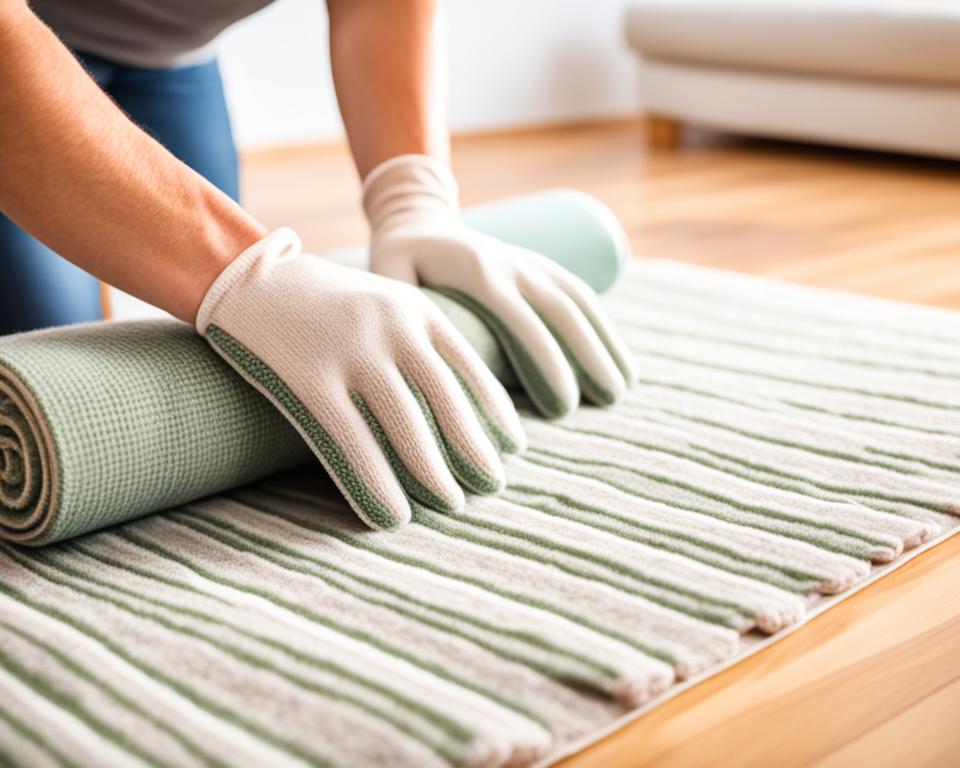
By carefully selecting hypoallergenic rugs and non-toxic rug adhesives for installation, you can significantly reduce allergy risks and enhance the comfort of your living space. Always stay informed about the latest materials, adhere to best practices during installation, and enjoy the peace of mind that comes from knowing you’ve made an allergy-conscious choice.
Conclusion
In summary, the common question of whether are rugs bad for allergies can be addressed with informed choices and careful maintenance. While rugs have the potential to harbor allergens, advances in rug materials and maintenance techniques have brought forth a variety of hypoallergenic rugs that significantly reduce this concern. By electing to incorporate allergy-friendly rugs made from natural fibers such as wool, cotton, jute, and sisal into your home, you’re choosing a healthier living environment.
Moreover, reducing allergens in rugs is not merely about choosing the right materials; it is also a matter of commitment to a regular cleaning schedule and adopting proper installation procedures using low-VOC adhesives. These steps are essential in ensuring your rugs contribute to a cleaner and more allergen-free home. Remember, the best rugs for allergies are the ones that align with both your lifestyle and health needs, enabling everyone in your household to breathe easier.
Your due diligence in selecting the right floor coverings and dedication to their upkeep will pave the way to a comfortable and stylish home that also guards against allergy flare-ups. Let the beauty of your chosen rugs complement your well-being, proving that you don’t have to sacrifice one for the sake of the other. With these tips, you’re well-equipped to create a harmonious and health-conscious living space.
FAQ
Are rugs bad for allergies?
Rugs can accumulate allergens such as dust mites, pet dander, and mold, which may exacerbate allergies for some people. However, choosing hypoallergenic or allergy-friendly rugs can mitigate these issues.
What type of allergens do rugs trap, and how do they affect indoor allergies?
Rugs trap allergens such as dust mites, pet dander, bacteria, mold, and mildew. These can trigger allergic reactions and affect the overall indoor air quality.
How does the age and type of rug impact allergen accumulation?
Older rugs and high-pile carpets tend to accumulate more allergens compared to newer and low-pile rugs. Regular cleaning and choosing the right type of rug can help reduce allergen buildup.
Are homes with smooth flooring better for allergy sufferers than homes with rugs?
Smooth flooring generally has lower levels of allergens compared to carpeted floors. However, selecting the right allergy-friendly rugs can help maintain good indoor air quality in homes with rugs.
Which is better for allergy sufferers, natural or synthetic fiber rugs?
Natural fibers like wool, cotton, and jute are often better for allergy sufferers because they have natural properties that resist allergens. Wool rugs, especially, are beneficial due to their ability to repel allergens and maintain freshness.
Can wool rugs prevent allergies, and how do they do it?
Wool rugs have natural oils that prevent the growth of dust mites and other allergens, making them a good choice for preventing allergies.
How can I identify hypoallergenic rug options for my home?
Look for rugs made from natural fibers like wool, jute, or sisal, and check for certifications or claims of hypoallergenic properties. Avoid rugs with chemicals or treatments that could trigger allergies.
What signs should I look for that indicate my rug may be causing an allergic reaction?
You might experience symptoms like sneezing, itchy skin, runny nose, or asthma attacks if your rug is triggering an allergic reaction.
How do scientific studies analyze the relationship between rugs and allergies?
Studies compare the levels of allergens in carpeted versus non-carpeted environments, investigate the impact of carpet age and type on allergen levels, and assess the indoor air quality associated with different rugs.
What benefits do allergy-friendly rugs offer?
Allergy-friendly rugs made from natural fibers like wool, cotton, jute, and sisal help minimize allergen accumulation, can be easier to clean, and contribute to a healthier indoor environment.
What is the link between rugs and Sick Building Syndrome?
Some studies suggest that certain carpet materials can contribute to Sick Building Syndrome by trapping allergens and emitting volatile organic compounds (VOCs), leading to a range of health symptoms.
How can I reduce allergens in my rugs?
Use proper vacuuming techniques with HEPA filters, clean your rugs regularly, and consider natural methods like using baking soda to eliminate dust mites and allergens.
What are the best rugs for allergy sufferers?
Hypoallergenic rugs made from natural materials like wool, jute, and sisal are considered the best options for allergy sufferers, due to their natural resistance to allergens.
How important is rug maintenance for managing allergies?
Regular rug maintenance, including vacuuming, spot-cleaning, and deep cleaning, is essential for minimizing allergens and maintaining indoor air quality.
What should I consider when choosing and installing new rugs to avoid allergic reactions?
Choose rugs made of natural fibers and use non-toxic, low-VOC adhesives for installation to prevent allergic reactions.
How have advancements in non-toxic rug adhesives contributed to allergy prevention?
Non-toxic rug adhesives reduce the emission of VOCs, improving indoor air quality and reducing the risk of allergic reactions associated with rug installation.
